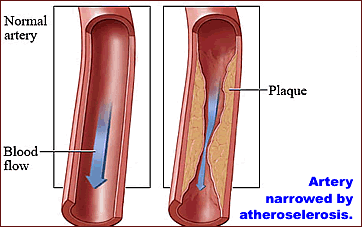HIV
Positive Men Have More Atherosclerosis and Higher Vascular
Age than Uninfected Men
 |
 |
 |
 |
 |
 |
 |
| SUMMARY:
HIV positive men without clinical coronary
artery disease were more likely than uninfected
men to have atherosclerosis
and subclinical signs coronary artery disease,
including 6.5% with significant blockage,
according to a recent computed tomography
study. In this analysis, risk increased
with longer duration of HIV infection. A
related analysis found that people with
HIV had a "vascular age" 15 years
greater than their chronological age. This
study produced the surprising finding that
people with higher CD4 counts were more
likely to develop coronary artery disease.
|
|
 |
 |
 |
 |
 |
 |
 |
By
Liz Highleyman
Research indicates that people
with HIV have a higher risk of cardiovascular
disease, but the relative contributions of HIV
infection itself, antiretroviral
therapy (ART), and traditional risk factors (such
as increasing age and smoking) are not fully understood.
In
the first study, published in the January
16, 2010 issue of AIDS, Janet Lo from Harvard
Medical School and colleagues investigated the degree
of subclinical atherosclerosis and its relationship
to traditional and non-traditional risk factors.
Atherosclerosis,
or "hardening of the arteries," refers to
the build-up of plaque composed of cholesterol, calcium,
and other substances in the arteries, leading to inflammatory
changes and impaired blood flow. People with coronary
artery disease -- atherosclerosis of the coronary
arteries that supply blood to the heart -- may experience
symptoms such as angina and are at increased risk
for myocardial infarction (MI), or heart attack.

This
study included 78 HIV positive men, with an average
age of 46.5 years and an average duration of HIV infection
of 13.5 years. The average CD4 count was high at 523
cells/mm3, and 81% had an undetectable viral load.
A control group included 32 HIV negative men of similar
age and demographic and cardiovascular risk factors.
HIV positive and negative participants had similar
Framingham 10-year MI risk scores, family history
of coronary artery disease, and smoking status. In
both groups, participants did not have a history or
symptoms of existing coronary artery disease.
The researchers used computed tomography coronary
angiography (CT scans of blood vessels) to determine
prevalence of coronary atherosclerosis, coronary stenosis
(narrowing of arteries), and amount of plaque.
Results
 |
Overall,
6.5% of the HIV positive participants had angiographic
evidence of obstructive coronary artery disease
(defined as > 70% narrowing), compared with
none of the HIV negative control subjects. |
 |
HIV
positive men had significantly higher measures
for multiple indicators of coronary heart disease
compared with HIV negative men: |
| |
 |
Coronary
atherosclerosis: 59% vs 34%, respectively
(P = 0.02); |
 |
Coronary
plaque volume: 55.9 vs 0 microl (P = 0.02); |
 |
Number
of coronary segments with plaque: 1 vs 0
(P = 0.03); |
 |
Prevalence
of Agatston calcium score > 0: 46% vs
25% (P = 0.04). |
|
 |
Among
HIV positive participants, the following factors
were significantly associated with plaque burden: |
| |
 |
Framingham
risk score; |
 |
Total
cholesterol level; |
 |
Low-density
lipoprotein (LDL or "bad" cholesterol)
level; |
 |
CD4/CD8
ratio; |
 |
Monocyte
chemoattractant protein 1 (MCP-1) level. |
|
 |
Duration
of HIV infection was significantly associated
with plaque volume and number of segments with
plaque. |
 |
This
association remained significant after adjusting
for age, traditional risk factors, and duration
of antiretroviral therapy. |
"Young,
asymptomatic, HIV-infected men with long-standing
HIV disease demonstrate an increased prevalence and
degree of coronary atherosclerosis compared with non-HIV-infected
patients," the study authors concluded. "Both
traditional and nontraditional risk factors contribute
to atherosclerotic disease in HIV-infected patients."
"Our data highlight the need to address cardiac
risk reduction early in the course of HIV disease,
before significant subclinical disease accrues and
before cardiac events occur," they recommended.
Coronary
Aging
In the second study, published in the December
1, 2009 issue of Clinical Infectious Diseases,
Giovanni Guaraldi from the University of Modena and
Reggio Emilia in Italy and colleagues investigated
whether HIV positive people on stable ART showed evidence
of greater vascular (blood vessel) aging.
This cross-sectional analysis included 400 HIV positive
patients attending a cardio-metabolic clinic. Most
were men and the mean age was 48 years. Participants
underwent computed tomography imaging to identify
coronary artery calcium -- an indicator of atherosclerosis.
Vascular age was estimated based on the extent of
calcium using published equations.
Results
 |
162
patients (40.5%) showed evidence of increased
vascular age. |
 |
On
average, vascular age was 15 years higher than
chronological age (range 1-43 years higher). |
 |
In
a univariate analysis, increased vascular age
was associated with the following factors: |
| |
 |
Older
chronological age; |
 |
Male
sex; |
 |
Hypertension
(high blood pressure); |
 |
Systolic
blood pressure; |
 |
Duration
of ART; |
 |
Fasting
glucose level; |
 |
Fasting
serum triglyceride level; |
 |
Total
cholesterol level; |
 |
LDL
level; |
 |
High-density
lipoprotein (HDL or "good" cholesterol)
level; |
 |
Presence
of metabolic syndrome. |
|
 |
In
a multivariate analysis controlling for potentially
confounding factors, higher current CD4 cell count
was the only significant predictor of increased
vascular age (P = .005). |
"Increased
vascular age is frequent among HIV-infected patients
and appears to be associated with CD4+ cell count,"
the investigators concluded. "If these findings
were to be confirmed in prospective trials, a positive
response to ART with an increase in CD4+ cell count
may become a marker of increased risk of atherosclerosis
development."
The researchers were unable to explain theunexpected
CD4 count findings, but suggested that greater inflammation
might play a role.
1/15/10
References
J
Lo, S Abbara, L Shturman, and others. Increased prevalence
of subclinical coronary atherosclerosis detected by
coronary computed tomography angiography in HIV-infected
men. AIDS 24(2): 243-253 (Abstract).
January 16, 2009.
G
Guaraldi, S Zona, N Alexopoulos, and others. Coronary
Aging in HIV-Infected Patients. Clinical Infectious
Diseases 49(11): 1756-1762 (Abstract).
December 1, 2009.